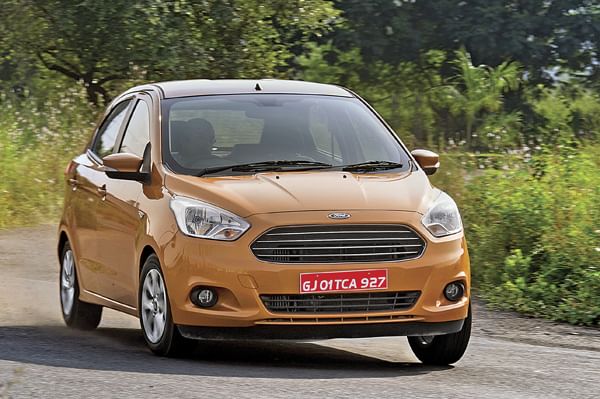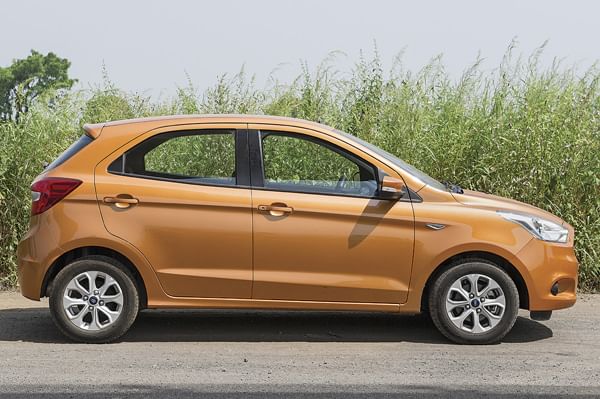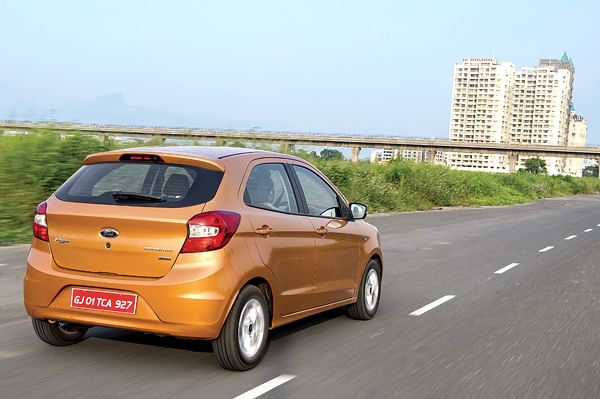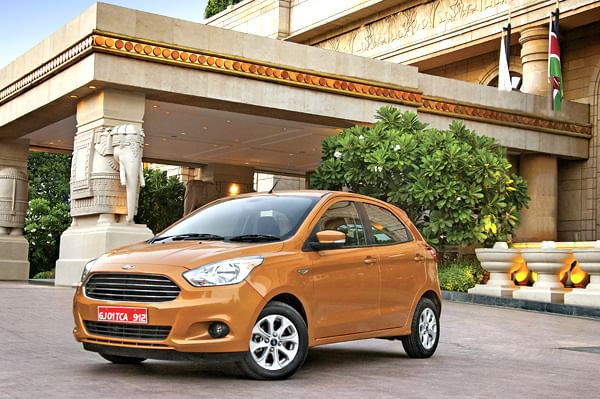Ford Figo review, road test
Read the Ford Figo review, road test from Autocar India; The second-generation Figo promises much. Our exhaustive road test tells you if it delivers.
Published on Nov 03, 2015 10:20:00 AM
1,69,977 Views
Follow us on



Developing a car for the finicky Indian hatchback buyer is no easy task. Just about every large car manufacturer has given it a shot, but only few have found real success. Ford happens to be among the notable inclusions in that short list. The last-gen Figo, launched in 2010, was its first mainstream hatchback for India, and straight off, Ford had got the formula right. Tough and practical without being too serious or dull, the Figo had it all. It was impressive enough to walk away with Autocar India’s Car of the Year award in 2011.
What you see here is the new Figo. ‘New’ because there’s little in common between the two generations of cars. This one’s built on a modern platform, features three different engines and can even be had with a dual-clutch automatic gearbox. Given that a lot of the car’s developmental work happened in India, there’s also the promise of the new Figo being even better suited to our conditions than the last one.
Could Ford have hit the bull’s eye once again? A detailed road test of the petrol automatic and diesel Figos gives us a clear answer.
If you’ve seen the Figo Aspire compact sedan, you’ve pretty much seen the Figo hatchback as well. The two cars are identical right up till the B-pillar. That means you get the same Aston Martin-esque front grille, peeled-back headlamps and general crisp, clean looks. Though it must be said, the hatchback has the nicer form from the rear doors on. The roofline flows quite naturally into the tail and there’s a good proportion to the design. However, as on the Aspire, the small 14-inch wheels are somewhat of a spoiler here too. It’s possible Ford designers opted for a smaller size that would correspondingly require smaller wheel wells in the interests of better cabin packaging and a good turning circle diameter (which is a decent 9.8 metres). Still, styling at the rear is neat with smart wrap-around tail- lamps and good definition to the tail gate. On the whole, the Figo looks attractive without being over the top in any way.
Where the two Figos differ is under their skins. The last Figo was a bit of a hand-me-down because it was built on a generation-old Fiesta platform. This one, however, is built on Ford’s modern B2E platform which has plenty in common with the EcoSport and now discontinued Fiesta sedan. The suspension components, basic floorpan and chassis are similar, but Ford has done away with the use of high-strength Boron steel (to keep costs in check) in this application. As a result, the chassis isn’t as stiff as an EcoSport’s. You can also tell the Figo isn’t built as solid as the other Fords either. That reassuring thunk you get on door shut is missing here. However, this Ford is among the lighter hatchbacks out there. The top-spec diesel one weighs in at 1,041kg, while the petrol automatic is even lighter at 1,037kg.
Another area where the Figo makes an impression is safety equipment. Even the base version gets a driver’s airbag as standard, middle versions get two airbags, while the top-spec Titanium + gets as many as six! It would have been nicer still if anti-lock brakes were not offered solely on the top versions.
There’s nothing out of the ordinary when talking of the Figo’s suspension – MacPherson struts up front work in tandem with a torsion beam at the rear. The Figo’s electric steering, however, features what Ford calls ‘pull drift compensation’. The system basically mildly increases assistance when it detects steering corrections needed to counter crosswinds or poor surfaces.
Just like the exteriors, the Figo and its Aspire sibling are near-identical on the inside as well. The only difference here is that the Figo cabin is finished in all-black plastics where the Aspire’s follows a richer dual-tone theme. Either way, you won’t mistake the cabin for anything but that belonging to a Ford’s, largely thanks to the familiar-looking dashboard. The basic-looking instrument cluster, busy centre console and elegant knurled dials for the climate control system are other things you are bound to notice. Top Titanium + cars get a digital (albeit old-school) readout atop the dash for Ford’s Sync infotainment system. Lower trim cars lose the screen, but instead feature Ford’s clever MyDock phone holder. It’s designed to hold phones of all sizes snugly and is a useful feature for those who frequently use their phone’s GPS systems for directions.
Visibility out the front is decent, but it would have helped to have reach adjust for the steering; the stretched-out driving position may not be to everyone’s liking. There’s enough space though, and the seats themselves are comfortable, if a bit soft. At the rear, there’s enough room for your legs and knees even with a tall front occupant; scooping out the front seatbacks has helped free up crucial space here. Aiding the feel of space are the large rear ◊ ∆ windows that give a good view out. As for comfort, the rear seatback is nicely reclined, but seat cushioning is a bit too soft and there are no adjustable headrests either.
Quality and fit-finish in the cabin are acceptable, but no more. You can tell Ford has cut costs and there’s a noticeable inconsistency between the textures on the plastics used in the cabin. The switchgear, though, works with a tactile and positive feel. What also works well are the small touches in terms of storage space and practicality. There’s the nook ahead of the gearlever (to stow away odds and ends) and the concealed pockets between the side of the dash and doors (useful for keeping your valuables in). Each front door can hold two bottles and the glovebox is decent-sized as well. Rear occupants won’t be as happy with storage spaces as there’s just a sole bottleholder for their use. On the positive side, the tail opens to reveal a sizeable 257-litre luggage bay. The rear seat back also folds forward, should you need more space. Unfortunately, the loading lip is a bit high and the boot floor is low, so you’ll have to lift heavy luggage more than you’d like.
For entertainment, there’s the par-for-the-segment Bluetooth, USB and aux connectivity for music, and steering-mounted controls. On the top Titanium+ trim, Ford provides a programmable key (MyKey) which allows the driver to set the top speed and maximum audio volume – a good way to keep your chauffeur or children in check.
As mentioned, the Figo will be available with three engine-gearbox combinations. There’s a 1.2 petrol with a five-speed manual, a 1.5 diesel with a five-speed manual and a 1.5 petrol with a six-speed dual-clutch automatic.
The dual-clutch auto version first. This one’s 1.5-litre petrol engine makes the most of its twin cams and variable valve timing architecture to produce a healthy 110.5bhp. The power figure makes the Figo automatic the most powerful of the mass market auto hatches in India. In town, the engine’s good bottom end responses help this version of the Figo build speed smartly. However, in slow-moving city traffic, you can feel the clutch engage, so shifts aren’t super smooth. But once on the go, the gearbox settles into its rhythm and responds well enough to changes in throttle position. It’s not lightning fast as the VW Polo’s twin-clutch unit, but it gets the job done.
At light loads, the gearbox will upshift at about 2,200rpm, but drive hard and it will hold to about 6,300rpm before shifting to the next ratio. Unfortunately, the gearbox’s Sport mode won’t let you hold gear beyond 6,300rpm (at which point the engine sounds thrashy) either, but does well to downshift and keep revs right in the heart of the powerband. Those driving on hilly roads will particularly like the engine braking effect of Sport mode. Drivers also have the option to shift gears manually in Sport, but only via the small ‘+/-’ buttons on the gear lever; there’s no traditional tiptronic function or paddle shifters on the steering. The gearbox is responsive to manual inputs, so you will find yourself making use of the buttons when conditions permit.
Performance on the whole is good. The dash from 0 to 100kph takes just 11.1 seconds – the VW Polo GT TSI does it in 11.02 seconds – and in-gear timings are decent as well.
But good as the auto Figo is, it’s the diesel that really impresses us. The engine is the latest version of Ford’s 1.5 diesel you’d find under the hood of the pricier refreshed EcoSport and Aspire, but the good news is that it’s not been dulled down for use in the cheaper hatch.That means power is a solid 98.9bhp! Couple that with a body that weighs all of 1,041kg and you are guaranteed excellent performance. 100kph comes up in 10.5 seconds, which makes the Figo diesel quicker than all the mass segment diesel hatchbacks, bar none.
Real-world performance also feels better than lower-powered rivals from the moment you set off. Responses are good right from idle, with a gentle surge speeding things up at about 1,600rpm. Thereon, there’s an even spread of power right till 4,000rpm. The engine’s not quick revving per se, but remains responsive throughout, even in fifth gear. The diesel engine also runs relatively quiet, though you can feel a buzz on the steering. Also worth mentioning is that gearshifts on the Ford IB5 gearbox are a touch notchy and aren’t suited to quick shifts. Driving in town, we also noted the diesel car’s clutch to be well weighted if springy in action.
The last Figo aced this section of our test, so it’s a bit hard to break the news that the new one isn’t quite as special in the handling department. There is some un-Ford-like slack at the steering and it doesn’t feel quite as sure-footed as the last one did around the corners. But that’s not to say the Ford isn’t nice to drive, because dynamics are actually good by class standards. The steering has decent weight to it (it feels better calibrated than the Aspire), high speed body movements are well contained and the brakes offer great feel and stopping power.
Straightline speed stability is also really good. However, at slower speeds, the Figo tends to feel a bit stiff-kneed on all but the smoothest city roads. The small 14-inch tyres also get swallowed by large potholes. The suspension does work quietly and bump absorption is generally good, but that little bit of Ford magic is missing on this Figo.
What is noteworthy though is that Ford seems to have addressed the bottoming-out issue that plagued the old Figo. Ground clearance on the new Figo is actually a class-best 174mm.
The Figo has plenty up its sleeve to ensure it can stretch each litre of fuel far. Of course, the low kerb weight helps but Ford has also given the Figo plenty of aero tweaks to make the car as aerodynamic as possible. There’s a rubberised lip spoiler up front that pushes the air flow under the components of the engine while there’s a ridge behind the mirrors to smoothen air flow around the windows. The Aspire also has small protrusions behind the rear wheel arches to prevent drag-inducing vortices from forming around the bumper. It all helps because the Figo diesel’s ARAI-tested fuel economy of 25.8kpl is among the best in class.
Top trim Titanium + Figos come with Ford’s Sync infotainment system. In today’s world of touchscreen everything, the system’s monochrome display looks dated, but usability-wise it’s fine. It’s easy to connect a phone to the system and what’s also nice is that voice-activated commands for music and telephone work without the need to put on an accent. However, the main highlight of the system is its ability to automatically use your phone’s network to alert emergency services in case of an accident.
It strikes the right balance between performance and practicality.
The new Figo looks smart, comes with a roomy enough interior and is also loaded with plenty of features. To many, the impressive safety kit on board the Figo should be reason enough to be very interested in it. Overall performance is also good, whether you opt for the petrol automatic (available in a single trim only) or diesel manual, and you wont have much to complain about the way it drives or rides either. Sure, its missing some of the sparkle that makes Fords special, but its still good by class standards. Where the Figo doesnt quite impress is in interior quality. The cabin doesnt feel quite as special as the competitions and thats one of the Figos only big shortcomings. What does help the Figo is its attractive pricing. With prices ranging from Rs 5.29-7.40 lakh (ex-showroom, Delhi) and three versions on offer, theres a Figo for every type of buyer and budget. The diesel Figo in particular comes across as great value, considering the power and performance on offer. On the whole, the new Figo fits the bill as a great all-rounder. Much like the last one did.
Copyright (c) Autocar India. All rights reserved.






Comments
Member Login
Personal Details
No comments yet. Be the first to comment.